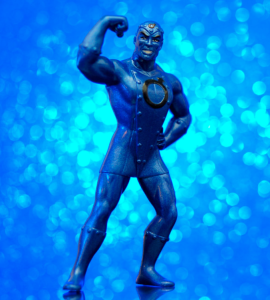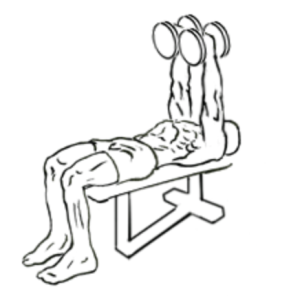19 Body Issues for Men
Lena Gammel
Body Image from Boys to Men
Male development of negative connotations surrounding body image changes as they age. Their masculine consciousness starts to develop in childhood when young boys see superheroes with massive muscles and automatically feel held to those standards, and this consciousness continues throughout a boy’s adolescent years. These false beliefs shape boys into developing unhealthy eating disorders to achieve more “attractive” bodies, which are socially valued forms of masculinity (Wright et al., 2016). Previous notions that body image does not affect boys and men are incorrect. Usually, those who struggle with body image go undiagnosed because this health issue is gendered, the primary focus being on white females (Wright et al., 2016).
Childhood
Stemming from a younger age, boys grow up revering cartoons, movies, and comics that feature superheroes with physical physiques that do not resemble most men. These superheroes build admiration among young boys who think they, too, need this physique that does not exist in real life (Front & Psychol, 2021). Even though we may not realize it, boys continuously grow up under influences and pressures to be stronger, leaner, and taller. Moreover, when boys see extreme bodies like Dwayne “The Rock” Johnson, this may lead to mental instability in a man’s physique (Front & Psychol, 2021).

“Metal Men: Iron (5/7)” by JD Hancock is licensed under CC BY 2.0
Adolescence
Today, 45% of the male teen population is unhappy with their body image compared to 15% in the early 1990s (Rawhide Youth Services, 2021). During a boy’s high school years, it is not uncommon to hear boys with body dissatisfaction focus more on intense muscle-building exercises and even steroids to improve looks (Blouin & Goldfield). Teenage boys want to achieve that muscular physique. This desire comes from the expected physical changes that occur in adolescents due to puberty. For boys, puberty marks the transition from a boy to a man, and with this transition comes masculine desire (John Hopkins Medicine, 2021). According to research, nearly 1 in 3 (29%) teenage boys think about their appearance at least five times a day (Rawhide Youth Services, 2021). This continuous preoccupation with appearance leads to some teens opting for steroid use in order to build a desired, although unobtainable, physique.

“Decline-triceps-extension” by Everkinetic is licensed under CC BY-NC-SA 3.0
Adulthood
Although a man’s body image remains a concern while aging, there is a developmental shift in one’s body image during the later years of life. Also, a second study found that older men report lower body dissatisfaction than younger men (de Souto Barreto et al., 2011). Men over 50 tend to have fewer concerns about how others perceive their body image to be. This lack of concern stems from most men. For example, a study found that men aged 67-90 years old discounted appearance as an unimportant and feminized concern. However, men stressed more about their health and body functionality, not their actual body image though (Hurd & Mahal, 2021). In addition, the study found that these older men are less likely to compare their bodies with others. (Jankowski et al., 2016). For example, when the researchers asked why appearance was inconsequential, the older men stated that they realized aging is out of their control and, therefore, not worth worrying about (Hurd & Mahal, 2021).
RACE/ETHNICITY
Negative body image is more than just disliking how one’s body looks; it is often debilitating. Men with body image issues are linked to lower self-esteem, lower life satisfaction, and a lack of confidence in themselves.
As previously stated, not much is known about men and how they feel about their body image issues. This is why healthcare professionals are often hesitant to address body image issues in men because of the lack of knowledge, limited time and resources, and inadequate training and guidelines on how to assist men (Swami, 2022).
The first step to overcoming body image dissatisfaction is to accept one’s body for the way it is and not try to “fix it” every second of your life; instead, celebrate all the things it can do (Chander, 2018). In addition, men and boys should adjust their social media platforms to only show content that will lead to positive feelings about their bodies. Furthermore, men should not be afraid of vulnerability. Possessing negative feelings about one’s body image does not challenge a man’s masculinity (Chander, 2018). Rather, it allows people to share their experiences; this is where healing comes from.
To combat this stigmatized body image, a couple of actions and changes can be implemented to promote a better relationship with body image for boys and men. First, adjusting what is shown on a young boy’s social media feed can help reduce exposure to negative/unrealistic comparisons. In addition, providing a safe place with no judgment to speak openly may allow boys and men to feel more comfortable opening up about their struggles with body image (Chander, 2018).
NEW DIRECTIONS FOR MALE BODY IMAGE
Negative body image is more than just disliking how one’s body looks; it is often debilitating. Men with body image issues are linked to lower self-esteem, lower life satisfaction, and a lack of confidence in themselves.
As previously stated, not much is known about men and how they feel about their body image issues. This is why healthcare professionals are often hesitant to address body image issues in men because of the lack of knowledge, limited time and resources, and inadequate training and guidelines on how to assist men (Swami, 2022).
The first step to overcoming body image dissatisfaction is to accept one’s body for the way it is and not try to “fix it” every second of your life; instead, celebrate all the things it can do (Chander, 2018). In addition, men and boys should adjust their social media platforms to only show content that will lead to positive feelings about their bodies. Furthermore, men should not be afraid of vulnerability. Possessing negative feelings about one’s body image does not challenge a man’s masculinity (Chander, 2018). Rather, it allows people to share their experiences; this is where healing comes from.
To combat this stigmatized body image, a couple of actions and changes can be implemented to promote a better relationship with body image for boys and men. First, adjusting what is shown on a young boy’s social media feed can help reduce exposure to negative/unrealistic comparisons. In addition, providing a safe place with no judgment to speak openly may allow boys and men to feel more comfortable opening up about their struggles with body image (Chander, 2018).
Key Takeaways from the Chapter
- Negative body image is associated with mental and physical health issues.
- Masculine body images are introduced early to boys. Pressure to conform to these masculine body images increases into adolescence but decreases in older ages.
- There are differences by race/ethnicity in how boys and men feel about their physical appearance.
Chapter Review Questions
1. What is body image?
-
- A. Being able to love your body at all times
- B. Refers to a person’s positive and negative perception of their own body
- C. Understanding your anatomy and why your body looks the way it does
- D. Only seeing the positive perception of one’s own body
2. What is the simplest step to overcoming body image dissatisfaction?
-
- A. Never address that you are concerned about how you look
- B. Being able to overcome vulnerability
- C. To accept your body for the way it is and not try to “fix it” every second
- D. All of the Above
3. Which race/ethnicity group had a more positive relationship with larger body sizes?
-
- A. Hispanic men
- B. White men
- C. African American men
- D. Asian men
4. Today, what percent of the male teen population is unhappy with their body image compared to 15% in the early 1990s?
-
- A. 45%
- B. 55%
- C. 35%
- D. 25%
References
Blouin, A. G., & Goldfield, G. S. (n.d.). Body image and steroid use in male bodybuilders.
The International journal of eating disorders. Retrieved October 4, 2022, fromhttps://pubmed.ncbi.nlm.nih.gov/7581418/#:~:text=Steroid%20users%20reported%20that%20the,enhanced%20bulimic%20tendencies%20than%20nonusers.
Chander, R. (2018, October 18). From hair to height: How male body image struggles go beyond
muscle. Healthline. Retrieved October 6, 2022, from https://www.healthline.com/health/mental-health/male-body-image-problems.
de Souto Barreto P., Ferrandez A. M., Guihard-Costa A. M. (2011). Predictors of body
satisfaction: Differences between older men and women’s perceptions of their body functioning and appearance. Journal of Aging and Health, 23(3), 505–528.
Frederick DA, Crerand CE, Brown TA, et al. (n.d.). Demographic predictors of body image
satisfaction: The U.S. body project I. Body Image. 2022;41:17-31. https://www-sciencedirect-com.libproxy.clemson.edu/science/article/pii/S1740144522000110. doi: https://doi-org.libproxy.clemson.edu/10.1016/j.bodyim.2022.01.011.
Front. Psychol., 21 May 2021 Sec. Human-Media Interaction
https://doi.org/10.3389/fpsyg.2021.626763
Hurd, L., & Mahal, R. (2021). “I’m pleased with My Body”: Older Men’s Perceptions and
Experiences of Their Aging Bodies. Men and Masculinities, 24(2), 228–244. https://doi.org/10.1177/1097184X19879188
Jankowski G. S., Diedrichs P. C., Williamson H., Christopher G., Harcourt D. (2016). Looking
age-appropriate while growing old gracefully: A qualitative study of aging and body image among older adults. Journal of Health Psychology, 21(4), 550–561.
NEDA Feeding Hope. (2022, March 1). Body image. National Eating Disorders Association.
Retrieved October 6, 2022, from https://www.nationaleatingdisorders.org/body-image-0
Nieri, T., Kulis, S., Keith, V. M., & Hurdle, D. (2005). Body image, acculturation, and
substance abuse among boys and girls in the Southwest. The American journal of drug and alcohol abuse, 31(4), 617–639. https://doi.org/10.1081/ada-200068418
Pallarito, K. (2016, March 18). Many men have body image issues, too. WebMD. Retrieved
October 6, 2022, from https://www.webmd.com/men/news/20160318/many-men-have-body-image-issues-too
Piatkowski TM, White KM, Hides LM, Obst PL. (2020). Australia’s adonis: Understanding what
motivates young men’s lifestyle choices for enhancing their appearance. null.;55(2):156-168. https://doi-org.libproxy.clemson.edu/10.1111/ap.12451. doi: 10.1111/ap.12451.
Johns Hopkins Medicine. (2021, August 8). Puberty: Adolescent male. Puberty: Adolescent
Male. Retrieved November 2, 2022, from https://www.hopkinsmedicine.org/health/wellness-and-prevention/puberty-adolescent-male
Rawhide Youth Services. (2021, April 14). Body image issues: The teen male edition. Body
Image Issues: The Teen Male Edition. Retrieved October 31, 2022, from https://www.rawhide.org/blog/infographics/body-image-issues/#:~:text=45%25%20of%20the%20teen%20male,least%205%20times%20a%20day
Ricciardelli, L. A., McCabe, M. P., Williams, R. J., & Thompson, J. K. (2007, February 7). The
role of ethnicity and culture in body image and disordered eating among males. Clinical Psychology Review. Retrieved October 5, 2022, from https://www.sciencedirect.com/science/article/pii/S0272735807000372
Swami, V. (2022, September 2). Body image issues affect close to 40% of men – but many don’t
get the support they need. The Conversation. Retrieved November 3, 2022, from https://theconversation.com/body-image-issues-affect-close-to-40-of-men-but-many-dont-get-the-support-they-need-179046#:~:text=Research%20shows%20that%2C%20in%20men,as%20severe%20anxiety%20and%20depression.
White, E. K., Mooney, J., & Warren, C. S. (2019). Ethnicity, eating pathology, drive for
muscularity, and muscle dysmorphia in college men: a descriptive study. Eating Disorders, 27(2), 137–151. https://doi-org.libproxy.clemson.edu/10.1080/10640266.2019.1585717.
White ND, Noeun J. (2016). Performance-Enhancing Drug Use in Adolescence. Am J Lifestyle
Med. Nov 29;11(2):122-124. doi: 10.1177/1559827616680593. PMID: 30202322; PMCID: PMC6125030.
Wright J, Halse C, Levy G. (2016) Preteen boys, body image, and eating disorders. Men and
Masculinities. ;19(1):3-21. https://doi-org.libproxy.clemson.edu/10.1177/1097184X15575158. doi: 10.1177/1097184X15575158.

